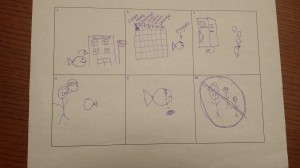Last Tuesday, some members from my school and I attended another Adolescent Literacy Learning conference in Norfolk. This workshop’s topic was on all about vocabulary instruction. As a foreign language teacher, this is kind of my thing. I will be the first to admit, though, that I am really great at vocabulary instruction in the lower levels (thanks to TPRS) but I am medicore in Spanish 3 and so far, an abysmal failure in AP Spanish. Ironically, I know that AP Spanish probably requires the most vocabulary instruction because of the level of materials we’re covering (for example, this week we’re attempting to tackle Sor Juana’s Hombres necios que acusáis) but as a teacher, the task is a little overwhelming.
One of the problems teachers might run into is not knowing what words to pull. My friend, the science teacher, scoffed at this assertation. In other content areas, it’s a little easier to decide what words students will need for the topic. For foreign language, we’re tasked with teaching all the words, but there is no way we can actually teach all the words, so after we cover the most frequent 100 or 1000… then what? Where do we go from there? It seems like in foreign language, we don’t realize we don’t know a word until we need it… and then explicit instruction is a little too late. I also find it really hard to keep up with the words we need to cover for each piece of input. (I teach all 4 levels, so 4 levels times prepping 1-3 pieces of input per class can quickly add up, even over the course of just one school day.)
The workshop started with an anticipatory guide with some questions about vocabulary learning and instruction. Me being the so-called expert I like to think I am, I was about half wrong (although two were on a technicality!!) about the research. What we did cover was that explicit vocabulary instruction is worth the time it takes. As a language teacher, I had to do a bit of exploratory thinking here, because I know that explicitly teaching grammar for foreign language, at least at the novice and intermediate levels, is not the best use of my time. But what about vocabulary? Then I realized that the very first step of TPRS and other comprehensible input strategies is to establish meaning. And establishing meaning is another way of explicitly teaching vocabulary. But just like in TPRS, this workshop showed that it’s not enough to just say the word once and go on; we need to have students do something with that language. And not just do something, but do something engaging and repetitive. As Dr. Feldman said, ‘get the words in their mouths’. No matter what discipline we teach in, students need to be making connections!
There were a number of strategies that we went on to discuss, such as having a vocabulary log, prioritizing words to teach, using academic language on our own and providing strategies and opportunities for students to respond using academic language, and using mnemonics. (You can view all the items from this workshop for free on the wikispace.)
The biggest takeaway for me was my whole philosophy on education and conducive to a growth mindset. Dr. Feldman mentioned ‘You have to be wrong to be right. It’s okay to be wrong, that means you’re in the game.’ This greatly echoes our keynote speaker from NILA, Linda Egnatz, who said that anything worth doing well is worth doing poorly at first. And me, I named this blog Making Good Mistakes for the exact same reason. Once kids are on the field and willing to play the game, that’s when we can work our teacher magic.
I wish I could find the link to a video that shows how including some of his simple strategies, like providing sentence frames, can turn mumbles, grumbles, and one word answers into collegiate, scholarly language in a snap. I think that was the most impressive part of the workshop. But since I can’t find it, you’ll just have to take Dr. Feldman’s advice and go for it! Are you in the game?



